
Phobaeticus is a genus of Asian stick insects comprising over 25 species. The genus includes some of the world's longest insects.

Phyllium is the largest and most widespread genus of leaf insects in the family Phylliidae (Phasmatodea). They can be found in Sundaland, Philippine Islands, Wallacea, and Australasia.
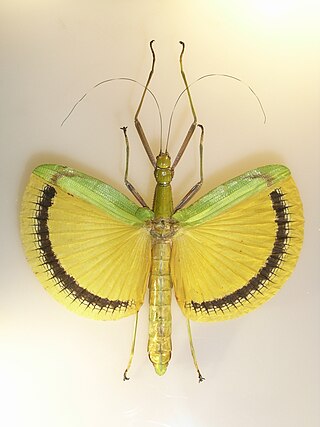
Necrosciinae is a subfamily of the stick insect family Lonchodidae, with its greatest diversity in South-East Asia.

Pulchriphyllium giganteum, commonly known as the Giant Malaysian Leaf insect, is a species of leaf insects described from Malaysia by Hausleithner in 1984 and placed in the genus Pulchriphyllium since 2021. Pulchriphyllium giganteum is the largest species belonging to the genus Pulchriphyllium reaching 105 mm in size. They are found most abundantly in the west Malaysian tropics. The females typically have large elytra that lie edge to edge on the abdomen and tend to lack hind wings making them usually flightless. Males have small elytra and sometimes transparent non-leaflike functional hind wings. Pulchriphyllium giganteum found in the wild tend to be mostly females and the first male of this species was not found until 1994. In captivity, the species has primarily been observed to reproduce through parthenogenesis meaning the females are asexual. The primary reproductive pattern in the wild is unknown. Eggs tend to be brown or black and glossy and resemble seeds. They hatch around 6 months after breeding. Newly hatched young nymphs tend to be wingless and brown or reddish in color. They develop their green color after feeding on leaves. Both the adult and larval stages are phytophagous meaning they feed on plants. The main plant food sources for this species are oak and bramble tree leaves.

Sceptrophasma hispidulum, commonly known as the Andaman Islands stick insect, is a species of the stick insect family. It originates from the Andaman Islands and is commonly found in tropical forests there. They eat a variety of foliage, though in captivity they commonly eat blackberry bramble, hawthorn, oak, rose, and lettuce. The species has the Phasmid Study Group number PSG183.

Aschiphasmatidae are a family of stick insects belonging to the suborder Verophasmatodea; they can be found in Indomalaya.
Dajaca is a genus of stick insects belonging to the suborder Verophasmatodea, family Aschiphasmatidae and is the only representative of the monotypic tribe Dajacini. Species have been recorded from Borneo, Vietnam, Hong Kong and Myanmar.
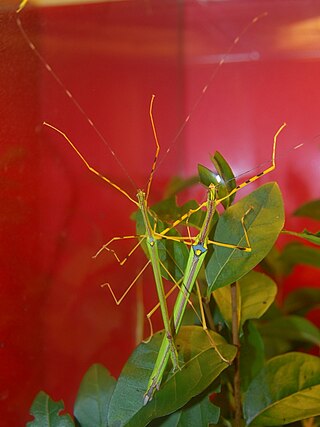
Necroscia is an Asian genus of stick insects in the family Lonchodidae and tribe Necrosciini. Species have been recorded from South-East Asia.

Pylaemenes is a genus of stick insects in the family Heteropterygidae and subfamily Dataminae. It combines small to medium-sized, often brightly colored Phasmatodea species. Their representatives are found in large parts of Southeast Asia.

The Lonchodinae are a subfamily of stick insects in the family Lonchodidae found in: Australasia, Asia, Africa, Southern America and the Pacific.

Calvisia is a genus of stick insects in the subfamily Necrosciinae. Species are known to be distributed in temperate and tropical Asia.

Neoclides is an Asian genus of stick insects in the subfamily Necrosciinae. Species have a known distribution from: Indo-China, Borneo, Sumatra, Philippines and New Guinea.

The Gratidiini are a tribe of stick insects based on the type genus Clonaria and first used by Cliquennois in 2005. Genera are known to be distributed in: Africa, Europe, temperate and tropical Asia and various Pacific Islands.

Heteropterygini is the only tribe within the subfamily of the Heteropteryginae. With 19 representatives described, this subfamily includes the fewest species of the three subfamilies, but includes the largest and most striking species of the family.
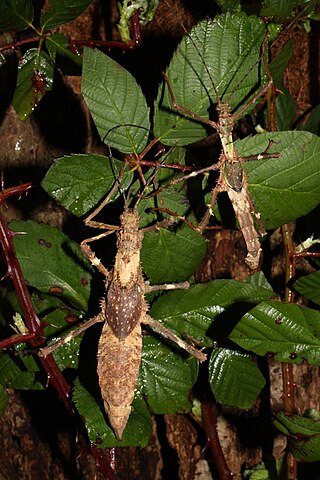
Haaniella is a genus of the Phasmatodea family Heteropterygidae from Southeast Asia.
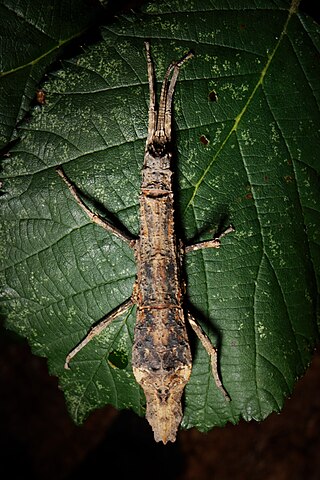
Pylaemenes elenamikhailorum is a species of stick insects native in Sepilok on Borneo. In application of the more recent differentiation between the genera Pylaemenes and Orestes the species is sometimes also called Orestes elenamikhailorum.
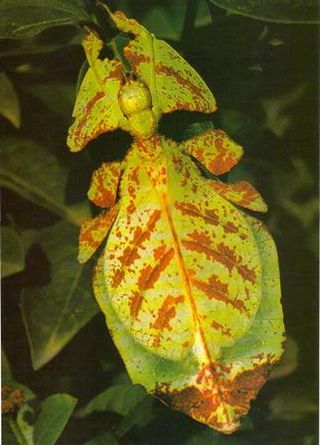
Pulchriphyllium is a genus of leaf insects. It was first established by Griffini in 1898 as a subgenus within the genus Phyllium and is a valid genus since 2021. The distinctive feature of Pulchriphyllium is the presence of lobes on the inside and outside of the fore tibia. In Phyllium are lobes only present on the outside. The representatives of the genus are native to both Sundaland and continental Asia.

Neohirasea is a genus of stick insects in the tribe Necrosciini, erected by J.A.G. Rehn in 1904. Species has been recorded from temperate and tropical Asia, including: China, India, Japan, Malaysia and Vietnam.
Scionecra is a genus of Asian stick insects in the tribe Necrosciini, erected by Heinrich Hugo Karny in 1923. Species have been recorded from: China, Vietnam, Malesia through to Australia.
Planososibia is a genus of Asian stick insects in the tribe Necrosciini, erected by Francis Seow-Choen in 2016. Species have been recorded from: Sri Lanka, Tibet, China, Vietnam and Malesia.

















